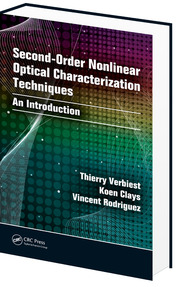Second-order Nonlinear Optical Characterization Techniques: An Introduction

Although chemists, biochemists, biologists, and material scientists are often
interested in using nonlinear optical techniques for characterizing their samples,
they seldom have the necessary background to exploit these methods. Designed
for nonspecialists, Second-Order Nonlinear Optical Characterization Techniques:
An Introduction focuses on the potential of second-order nonlinear optics as
a powerful characterization tool. Avoiding extensive mathematical details, this
multidisciplinary book does not require a background in advanced mathematics
or physics.
After introducing linear optics from the perspective of polarizability and
linear susceptibility, the authors cover incoherent second-harmonic generation.
They then deal with the study of surfaces and interfaces, exploiting the intrinsic
surface sensitivity of second-harmonic generation and sum-frequency generation.
The final chapter discusses second-order imaging techniques, including confocal
microscopy and two-photon excited fluorescence microscopy.
Accessible to a wide range of scientists, this concise book stresses the reliability
of nonlinear optical processes for probing surfaces and interfaces. Drawing
on the insight offered in the text, scientists from many disciplines can now
clearly understand and use second-order nonlinear optical methods.
Click here for further information
Terms
While we only use edited and approved content for Azthena
answers, it may on occasions provide incorrect responses.
Please confirm any data provided with the related suppliers or
authors. We do not provide medical advice, if you search for
medical information you must always consult a medical
professional before acting on any information provided.
Your questions, but not your email details will be shared with
OpenAI and retained for 30 days in accordance with their
privacy principles.
Please do not ask questions that use sensitive or confidential
information.
Read the full Terms & Conditions.